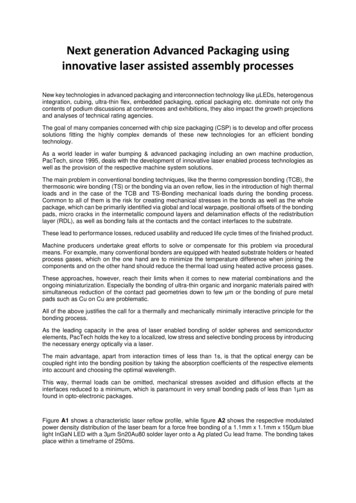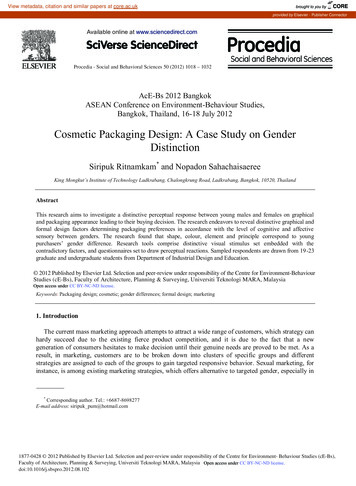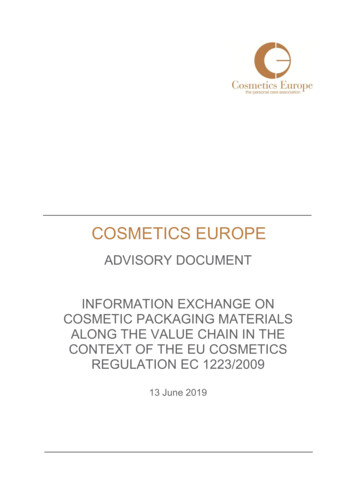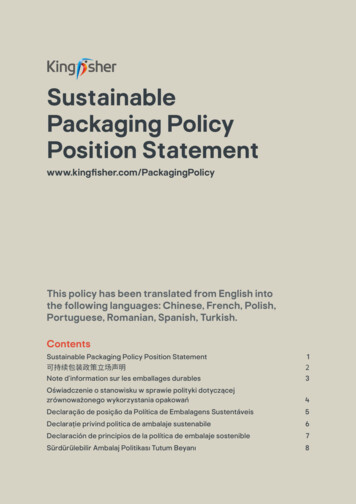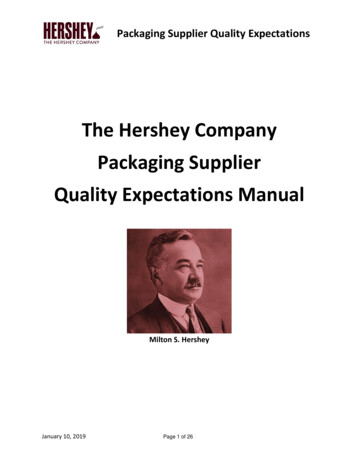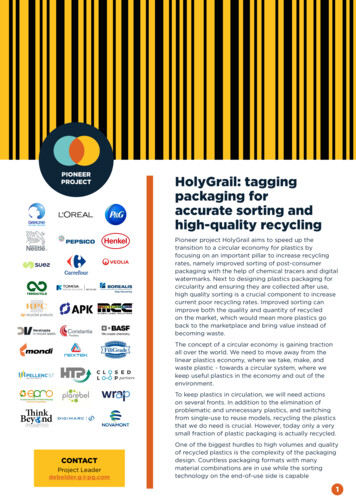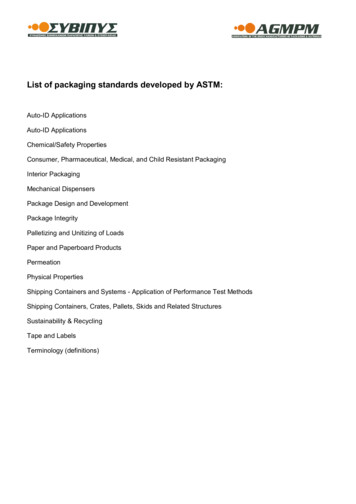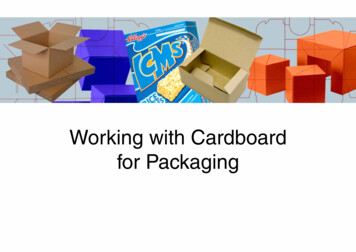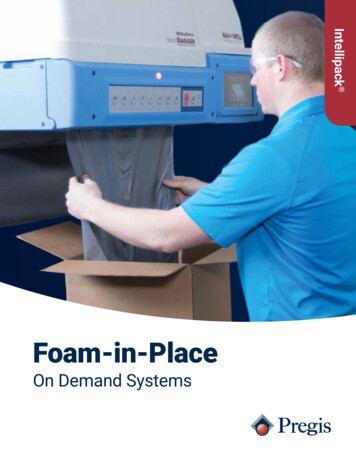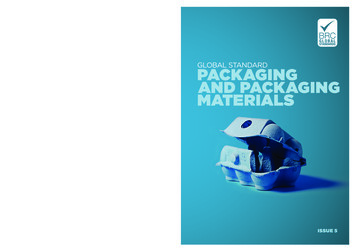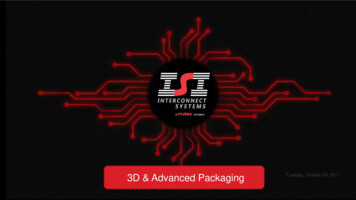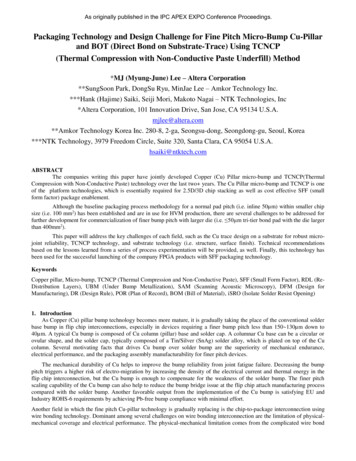
Transcription
As originally published in the IPC APEX EXPO Conference Proceedings.Packaging Technology and Design Challenge for Fine Pitch Micro-Bump Cu-Pillarand BOT (Direct Bond on Substrate-Trace) Using TCNCP(Thermal Compression with Non-Conductive Paste Underfill) Method*MJ (Myung-June) Lee – Altera Corporation**SungSoon Park, DongSu Ryu, MinJae Lee – Amkor Technology Inc.***Hank (Hajime) Saiki, Seiji Mori, Makoto Nagai – NTK Technologies, Inc*Altera Corporation, 101 Innovation Drive, San Jose, CA 95134 U.S.A.mjlee@altera.com**Amkor Technology Korea Inc. 280-8, 2-ga, Seongsu-dong, Seongdong-gu, Seoul, Korea***NTK Technology, 3979 Freedom Circle, Suite 320, Santa Clara, CA 95054 U.S.A.hsaiki@ntktech.comABSTRACTThe companies writing this paper have jointly developed Copper (Cu) Pillar micro-bump and TCNCP(ThermalCompression with Non-Conductive Paste) technology over the last two years. The Cu Pillar micro-bump and TCNCP is oneof the platform technologies, which is essentially required for 2.5D/3D chip stacking as well as cost effective SFF (smallform factor) package enablement.Although the baseline packaging process methodology for a normal pad pitch (i.e. inline 50µm) within smaller chipsize (i.e. 100 mm2) has been established and are in use for HVM production, there are several challenges to be addressed forfurther development for commercialization of finer bump pitch with larger die (i.e. 50µm tri-tier bond pad with the die largerthan 400mm2).This paper will address the key challenges of each field, such as the Cu trace design on a substrate for robust microjoint reliability, TCNCP technology, and substrate technology (i.e. structure, surface finish). Technical recommendationsbased on the lessons learned from a series of process experimentation will be provided, as well. Finally, this technology hasbeen used for the successful launching of the company FPGA products with SFF packaging technology.KeywordsCopper pillar, Micro-bump, TCNCP (Thermal Compression and Non-Conductive Paste), SFF (Small Form Factor), RDL (ReDistribution Layers), UBM (Under Bump Metallization), SAM (Scanning Acoustic Microscopy), DFM (Design forManufacturing), DR (Design Rule), POR (Plan of Record), BOM (Bill of Material), iSRO (Isolate Solder Resist Opening)1. IntroductionAs Copper (Cu) pillar bump technology becomes more mature, it is gradually taking the place of the conventional solderbase bump in flip chip interconnections, especially in devices requiring a finer bump pitch less than 150 130µm down to40µm. A typical Cu bump is composed of Cu column (pillar) base and solder cap. A columnar Cu base can be a circular orovular shape, and the solder cap, typically composed of a Tin/Silver (SnAg) solder alloy, which is plated on top of the Cucolumn. Several motivating facts that drives Cu bump over solder bump are the superiority of mechanical endurance,electrical performance, and the packaging assembly manufacturability for finer pitch devices.The mechanical durability of Cu helps to improve the bump reliability from joint fatigue failure. Decreasing the bumppitch triggers a higher risk of electro-migration by increasing the density of the electrical current and thermal energy in theflip chip interconnection, but the Cu bump is enough to compensate for the weakness of the solder bump. The finer pitchscaling capability of the Cu bump can also help to reduce the bump bridge issue at the flip chip attach manufacturing processcompared with the solder bump. Another favorable output from the implementation of the Cu bump is satisfying EU andIndustry ROHS-6 requirements by achieving Pb-free bump compliance with minimal effort.Another field in which the fine pitch Cu-pillar technology is gradually replacing is the chip-to-package interconnection usingwire bonding technology. Dominant among several challenges on wire bonding interconnection are the limitation of physicalmechanical coverage and electrical performance. The physical-mechanical limitation comes from the complicated wire bond
design rule (i.e. wire angle, length, loop control, bond pad, and finger dimension per wire size) which results in a limited IOdensity of wire bond devices and gates to achieve package miniaturization. It is a well known fact that enabling the Fine PitchCu Pillar Technology is the most effective way of solving these issues and challenges while achieving a higher IO densitywithin the smallest form factor package possible and improving electrical performance. This paper will mainly discuss thechallenges on packaging process technology: how to engineer a Cu pillar structure, how to decide substrate structure (i.e.bond on trace) and surface finish, and how to establish a manufacturing friendly assembly process (i.e. TCNCP versus massreflow).2. Package Structure, Bumping and Assembly Process FlowConventional FCBGA and chip scale fcCSP packages consist of a silicon chip, bumps (solder or Cu pillar), capillary ormolded underfill encapsulant, a thermal lid, an organic laminated substrate (Figure 1).Figure 1. FCBGA and fcCSP PackagesIn order to put bumps on silicon chips, it is required to layer UBM (under bump metallization) over either Aluminum orCopper metal pads mainly for the component reliability and performance. Typical UBM stacks comprise of two to four layersof certain metals, of which the most commonly used are Titanium, Copper, Tungsten, Palladium, and Nickel. The thickness ofthe metal pad and each metal layer in the UBM stack vary according to the silicon and bump design, as well as the productapplication. RDL (re-distribution layers) using Cu traces are often used to apply Cu pillar bump for a silicon die designed forwire bonds. The typical structure and process flow of RDL, Bump and Assembly is shown in Figure 2 and Figure 3.Figure 2-a. Typical structure of Cu bump with RDLFigure 3-a. Process flow of RDL and BumpFigure 2-b. Typical structure of Solder bump with RDLFigure 3-b. Process flow of Mass reflow CUF vs. TCNCP
3. Packaging Experimentation3.1 Test Vehicles, Variables, and Boundary conditionsThe objective of developing Fine Pitch Cu Pillar Technology is to establish a platform interconnection technology which cansupport a wide range of existing and future products. Hence, it is crucial to understand upfront the boundary conditions ofeach variable (i.e. bump pitch, die size, package type, substrate structure, etc.) and the reaction among factors. This is toensure that the offering is an effective solution per the specific design and application. In conducting multipleexperimentations in sequence, we have applied more extended design rules for the test vehicles than the baseline design rules(Table 1) already used for HVM (High Volume Manufacturing) production. This is to determine the technology extensioncapabilities.Table 1. Baseline Design Rule in HVM Package body size: 27x27mm2 and 35x35mm2 FCBGA with 1-2-1 build-up using 800um thick core (GX13/E679). Package type: Bare die, SPL (Single piece lid), and TCFCBGA (which is molded FCBGA, FCmBGATM). Silicon die: 1 metal layer daisy chain with 12x12mm2 and 12x16mm2, full stack 9 metal layer using 28nm node technologywith 10x10mm2 and 10x21mmm2 (1x2 tiles of 10x10mm2). The layout of the substrate top metal is shown in Figure 4. Thefull stack die test vehicle is to make sure we do not miss any critical reliability coverage from the 1 layer mechanical dieTV. Die thickness: 500um and 780um have been evaluated to understand any impact from warpage. Bump pad pitch: Staggered 30/60um in two row and tri-tier staggered 40/80um for the Design For Manufacture study. Thecircular bumps are 30um in diameter with 40um height with a thicker SnAg solder cap, and Ovular bumps are 20x45umUBM with 40-45um height with a thinner SnAg cap (Figure 5). Surface finish of package substrate: Immersion Tin (IT), Electroless Nickel Electroless Palladium Immersion Gold(ENEPIG).Table 2. The factors and variables in the Test Vehicles
Figure 5-a. Ovular Bump and the BOT (Bond-on-Trace) on Immersion SnFigure 5-b. Circular bump and the BOT (Bond-on-Trace) on Immersion SnFigure 6. Other Surface Finishes and the cross-sections3.2 Assembly3.2.1TCNCPThe TCNCP process for chip attach and underfill have been used for assembly due to the bump pitches being fine pitch. Atypical TCNCP process is shown in Figure 7.
Figure 7. TCNCP processTCNCP process characterization is very important for each and every new product due to the different combination of diesize, die thickness and Cu pillar bump layout. This is essential to avoid reliability failures induced by improper manufacturingcontrol. Good NCP(Non-Conductive Paste) coverage can be obtained by optimum NCP dispense pattern, volume, andbonding time and force. Visual inspection for checking the coverage and fillet height along die edge will be the first step.CSAM (Confocal Scanning Acoustic Microscopy) and/or X-ray is a non-destructive way for inspecting NCP voids, while plap (parallel lapping) is a destructive test method. Good alignment of the Cu pillar bonding on the substrate trace is anotherimportant item, which can be checked through x-ray inspection. Often, cross-sectioning at each corner of the dies is used forvalidating the off-set bonding. Lastly, checking solder wetting between the Cu pillar and substrate trace is the most criticalstep in the characterization. Cross-section is one of the methods for checking the solder wetting condition. Resistancemeasurement by electrical test prior to cross-sectioning would be the ideal way to locate any bonding has micro-cracking ordiscontinuity issues.Figure 8. Example of NCP Dispense pattern, NCP coverage, NCP Fillet Height3.2.1.1 Package Warpage and CoplanarityBecause the test vehicle packages are as large as 27mm and 35mm, it is important to understand the behavior of the packagewarpage and BGA coplanarity. Bare-die FCBGA package warpage and BGA coplanarity data show significant impact frombody size and die thickness (Tables 3 and 4)Table 3. BGA coplanarity per body size and die size/thicknessTable 4. Bare-die FCBGA Package Warpage trend
3.2.1.2 Reliability TestsAll test vehicles were subjected to the reliability stress tests per JEDEC Standards, as listed in Table 5. Besides, electricalOpen/Short tests, SAM (Scanning Acoustic Microscopy) tests were performed for each readout point, time 0 and200/500/1000/1500 hours/cycles.Table 5 Reliability test items and conditions4. Findings and Lessons Learned4.1 Substrate Design4.1.1Surface FinishElectrolytic Sn or Ni/Au plating are common surface finish technologies that have been qualified and being applied for HVMBOT packaging. However, these technologies could be good for the packaging using strip format substrates with wider bumppitch (i.e. larger than 50um inline), but are not suitable for the single unit format packages with high density design (i.e. lessthan 50um bump pitch) due to tight DR (design rules) and cost. Alternatively, electro-less plating technology becomes a morecost effective solution for the devices requiring fine bump pitch TCNCP and BOT. Hence, we have evaluated Immersion Sn,ENEPIG (Electro-less Nickel Electro-less Palladium Immersion Gold), DIG (Direct Immersion Gold), and Solder Coatsurface finishes as shown in Figures 5 and 6.4.1.2 Substrate StructureAs it was already explained in Section-3 Design Enablement, there are many challenges on the design and layout of thesubstrate for TCNCP applications. Trench pattern solder resist opening is one of a common techniques which canaccommodate larger number of IOs by utilizing limited space effectively. This pattern is shown in Figure 9.
Area Array Flip Chip DesignFine Pitch Perimeter Flip ChipFigure 9. Trench Pattern Solder Resist Opening for BOT of fine pitch perimeter micro-bumps4.2 Findings-1: Open failure from Immersion Sn plated test vehicleVery obvious failures that we observed were open failures occurring at the interface between the Cu-pillar and BOT trace.The failure might be initiated from the Level-3 MRT (Moisture Resistance Test), and propagated further during temperaturecycling (Figure 10). Most of failed pins are located on the middle row at the peripheral site. Larger body (35x35mm) andThicker Die (780um) yielded higher open failures than smaller body (27x27mm) and thinner die (500um).Figure 10. FA of open failure at 500 cycles TCB(Temperature Cycle, Condition ‘B’)of opens failuresFigure 11. Commonality of locationFigure 11 explains that die tilt might cause an insufficient solder joint at time zero and resulted in open failures after thermalcycling.Figure 12 shows Cu undercut is prone to happen in the middle row of the trace, which might be proportioned to the platingtime and/or length of Cu pad.Figure 12. Cross section of Cu undercut4.2.1 Lessons learnedUse of Immersion Sn as a surface finish for fine pitch device substrates has higher risks in micro-joint open failures due to Cuundercut and the insufficient amount of solder volume for the bump to trace joint. Major differences in Electrolytic Sn platingand Electroless Immersion Sn plating are the thickness control per the plating method. Electrolytic Sn plating is an additiveplating, so the thickness can be added over 3um without impacting Cu, while electroless immersion Sn plating is a chemicalsubstitution plating which replaces Cu. Therefore, thicker Sn plating thicknesses in Immersion Sn plating means there is moreCu undercut, which will result in more solder consumption in the micro-joint system, which end up yielding non-wetting(open failures) during thermal cycling.
4.3 Finding-2: Open failure from ENEPIG with Flat-Plug structure4.3.1 Flat Plug structureThis is the structure where the SR (solder resist) is coated on the pad (trace) side-walls and plugs gaps between pads (traces).This technology is beneficial in helping to prevent Cu undercut, excess electroless plating, NCP trapped voids during theTCNCP process, and reinforcement of pad (trace) adhesion. The structure and advantages of Flat-Plug are shown in Figure13-a and 13-b.Figure 13-a. Cross-section and Structure of ENEPIG with Flat-PlugFigure 13-b. Advantages of Flat-Plug Structure4.3.2 Mechanism of solder outflow on ENEPIGEven with the use of the Flat-Plug structure with ENEPIG plating, we observed another obvious open failure during HTS(high temp storage). The open in the micro-joint happened due to the solder outflow over the ENEPIG surface, which resultsin insufficient solder. It was confirmed that the solder outflow is in proportion to the area of the ENEPIG bump landing pad.Figure 14 illustrates the mechanism of the open failure.Figure 14-a: Progress of solder outflow during MRT (Moisture Resistance Test) and HTS (High Temperature Storage)Figure 14-b: Solder outflow per landing pad area (ENEPIG)
4.3.3 Lessons learnedChanging the surface finish from Immersion Sn to ENEPIG for the Cu-bump bond on the trace was very effective. However,we have learned that the total area of the bump landing pad should be limited within some range because the excellentwettability of ENEPIG with solder will consume an extra amount of solder.4.4 DIG and Solder CoatBoth DIG (Direct Immersion Gold) and solder coat surface finishes have demonstrated good wetting with SnAg solder of theCu bump without Cu undercut. Though these two surface finish methods demonstrated good micro-joint interconnection andpassed reliability tests, these options are yet to be favored for production due to the limited supply chain and being less costcompetitive. The interconnection quality of post 500TCB (Temperature Cycle Condition ‘B’) is shown in Figure 15.Figure 15. Cross-section of post 500TCB for DIG and Solder coat4.5 Finding-3: ENEPIG on iSRO pad with Flat plug structureBased on the lessons learned from multiple DOEs, it has been realized that the area of the bump landing pad for BOT willneed to be kept as small as possible to minimize the solder outflow. Figure 16 is an innovative practice of structuring isolatesolder resist opening (iSRO) with the Flat plug structure. The benefits of the iSRO with Flat Plug are not allowing Cuundercut but limiting the very small amount of solder outspreading. The structure of iSRO with Flat-plug is shown in Figure16.Figure 16. Design of iSRO BOT with Flat-plugWe have been able to demonstrate the robustness of the iSRO with Flat-plug structure in both TCNCP manufacturability aswell as the long term CPI (Chip Package Interaction) reliability. The test vehicles used for the company technologyqualification have passed 2000 cycles TCB (Temperature Cycle Condition ‘B’) and 1000 hours HTS and 96 hours uHAST(unbiased-HAST) with no failures so far. The actual cross-section of post 2000TCB (Temperature Cycle Condition ‘B’) isshown in Figure 17. Figure 18 shows the actual images of the Cu-bumps on chip and substrate top metal layers of the testvehicles evaluated.
Figure 17. Cross-section of post 2000TCB bond of iSRO-Flat PlugFigure 18. Actual substrate layer and Bump of the product SFF test vehicle5. ConclusionsThe comprehensive development work has successfully demonstrated the robustness of manufacturability and reliability ofCu-pillar micro-bumps and TCNCP using iSRO with Flat-plug structure substrates. A few additional engineering validationswill be able to support even larger die (400mm2) and larger body size FCBGA packages. All the learning from these series ofexperiments can help to identify a cost effective packaging solution where fine pitch Cu-pillar bump is necessary, too.Finally, the technology has been applied for the successful launching of the company products. Additionally, this technologybecomes a platform interconnection technology for cost effective advanced packaging (i.e. 2.1D and F2F), where high densitymicro-joint interconnection is required.6. ACKNOWLEDGMENTSThis research was conducted over a two year long intensive engineering collaboration effort among Amkor R&D, NTK,and Altera Package R&D groups. Special thanks go to the Amkor Korea R&D team, and NTK Co., Ltd.7. REFERENCES[1] Yang-Gyoo Jung, Myung-June (MJ) Lee et al, “Development of Large Die Fine Pitch Flip Chip BGA Using TCNCPTechnology” Electronic Components and Technology Conference, San Diego, CA, May 2012.[2] JEDEC Solid State Technology Association. JESD22-A104D, Thermal Cycling.
the metal pad and each metal layer in the UBM stack vary according to the silicon and bump design, as well as the product application. RDL (re-distribution layers) using Cu traces are often used to apply Cu pillar bump for a silicon die designed for . Bump and Assembly is shown in Figure 2 and Figure 3. Figure 2-a. Typical structure of Cu .
